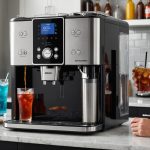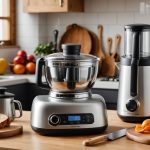Overview of Digital Nutrition Scales
Digital nutrition scales are not just ordinary kitchen scales. They combine technology and dietary science to help users keep track of macronutrient information. The primary purpose is to offer detailed nutritional insights by weighing and analyzing food content. This can significantly benefit those focused on dietary management and planning balanced meals.
Effective macronutrient tracking includes monitoring the intake of proteins, carbohydrates, and fats—crucial elements for maintaining or achieving specific health goals. By knowing exactly what is in each meal, individuals can tailor their diet to meet personal requirements or health plans, making their nutrition journey more manageable and accurate.
Have you seen this : Boosting Kitchen Hygiene and Nutrition: Discover How UV Light Sanitation Devices Revolutionize Food Safety
When selecting a digital nutrition scale, several key features should be considered to ensure accuracy and efficiency. Look out for scales with a comprehensive database of foods, allowing easy access to nutritional information. Connectivity features, such as Bluetooth or app integration, can simplify tracking by syncing data to smartphones or other devices.
Moreover, the scale’s ability to automatically update and expand its database is beneficial for up-to-date dietary information. User-friendly displays and precise measurement increments further enhance the utility of a digital nutrition scale, ensuring reliable and efficient use in any kitchen setting.
Also to see : Transform Your Diet: How an Organized, Labeled Pantry Boosts Healthy Eating
Top-Rated Digital Nutrition Scales
Exploring the top contenders in the market lets consumers make informed decisions. Among the best digital nutrition scales is Scale A, praised for its innovative features. Equipped with Bluetooth connectivity, Scale A synchronizes dietary data with mobile applications, allowing seamless integration into daily life. Users commend its macronutrient tracking capabilities, which provide detailed nutritional breakdowns, enhancing dietary management.
Meanwhile, Scale B offers robust specifications with a vast food database for accurate nutrition analysis. Its sleek design and intuitive interface have garnered positive user reviews, making it straightforward for individuals seeking a user-friendly option. Its precise macronutrient tracking abilities support tailored meal plans.
Lastly, Scale C excels in precision and reliability. Known for its extensive range of measurements and durable build, it receives high ratings from both experts and everyday users. Its ability to offer comprehensive macronutrient tracking makes it an asset for meticulous nutrition management.
-
Key considerations when reviewing scales include:
-
Connectivity options
-
User interface
-
Measurement accuracy
Each brings unique strengths to the table, catering to diverse needs in nutrition tracking and kitchen efficiency.
Buying Guide for Digital Nutrition Scales
When investing in nutritional scales, it’s essential to prioritize features that enhance accuracy and usability. Opt for scales with precise measurement capabilities and extensive databases to facilitate nutrition tracking. Look for models that offer seamless kit integration with smartphones through Bluetooth or app connectivity, ensuring effortless data syncing.
Budget-friendly options are available without compromising quality. It’s important to consider price ranges and establish a budget that aligns with your needs. While high-end scales may offer extra features, affordable ones can adequately meet basic nutrition tracking requirements.
Brand reliability is crucial. Research various brands for their reputation in producing high-quality digital kitchen scales. Reliable customer service is another aspect to consider, offering support in case of malfunctions or necessary updates. Thorough product reviews often shed light on user experiences and overall satisfaction.
To sum up, choosing the right digital nutrition scale involves evaluating essential features, aligning with your budget, and trusting reputable brands. With the right scale, meal planning and dietary management become more structured and effective, catering to specific health and nutrition goals.
Tips for Effective Use of Digital Nutrition Scales
To master the use of digital nutrition scales, start with correct calibration. Regular calibration ensures measurement precision, which is vital for accurate macronutrient tracking. Follow the manufacturer’s instructions for calibrating your specific model, and adjust settings as needed to account for different environments.
Next, optimise kitchen efficiency by following best practices for weighing various food types. Use a clean, flat surface, and tare the scale after placing a container on it to zero out its weight. This practice eliminates additional weight, ensuring precisely measured ingredients.
Integrating scales into meal planning can enhance your nutrition tracking routine. Weigh each ingredient as you prepare meals, recording data to track progress accurately. Utilising app connectivity can streamline this process by automatically syncing nutritional information to your smartphone or tablet, making meal adjustments simple.
These scales offer a comprehensive analysis of dietary intake, helping users meet individual health goals. By leveraging the feature-rich capabilities of digital nutrition scales, you’re better equipped to tailor meals to specific needs, making meal planning both efficient and accurate. Adopting these practices promotes consistent nutritional management in any kitchen setting.
Visual Aids and Comparison Charts
Incorporating visual aids and comparison charts in your decision-making process for digital nutrition scales is a strategic move. These tools simplify the evaluation of various scale features, providing a clear, graphical representation of each product’s strengths and weaknesses. By offering side-by-side comparisons, they help identify which scale best meets specific nutrition tracking needs, ensuring a more informed purchasing decision.
Visuals not only engage users but also convey complex information in a digestible format. For example, comparison charts highlighting macronutrient tracking capabilities, connectivity options, and design elements make it easier to spot differences and similarities among scales. This can be particularly useful for those who prioritize specific features, such as app integration or database comprehensiveness.
When searching for reliable product visuals and charts, consider sources like expert review sites and manufacturer websites. These often provide detailed, high-quality images and charts that accurately reflect the actual products. Utilising such tools ensures a thorough understanding of what each digital nutrition scale offers, allowing you to make a choice that aligns with your dietary goals and kitchen efficiency requirements.





